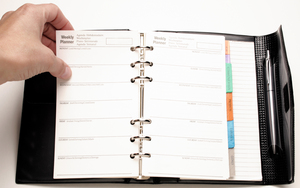If you have trouble following tasks through to completion, or frequently find yourself forgetting appointments and scheduled meetings, a day planner can help you become prompt, increase your organization skills and stay focused. Simply purchasing a day planner is not enough, though. Learn ways to make the most of this handy tool.
Go to a store that sells day planners so you can pick them up to see if one feels too small or another too bulky. Look at the different features, such as line sizes, pockets and built-in calculators. Is there a place to store pens and pencils or other items that you would need in a day planner? Make sure the day planner is something you can easily carry with you no matter where you go.
Carry your day planner with you everywhere and write down everything that you will need to know later. For instance, you might be in line at the grocery store when a client finally returns your call. Having your day planner at the ready allows you to schedule an appointment immediately rather than intending to do so later and forgetting.
At the end of the day, list tomorrow’s errands, projects and appointments on the next day’s page in the planner. Start with items that you must complete. Write these in pen, and schedule blocks of time in which to perform these tasks. Leave a space and in pen or pencil list the chores that you should complete, if time allows. Finally, use a pencil to list the things you would like to work on if you have extra time at the end of the day, or if you complete a task in less time than you allotted.
Determine whether you can delegate or otherwise remove any of the tasks listed. At the end of the day, if there are any items left in the list, erase those in pencil and move them all to the next day’s page. Also, at the end of each week, look forward at the next week or two. Jot down reminders ahead of time for projects that are coming due, such as a presentation for a new client or a report for school, so that you will have ample time to complete them.
Assign colors to different categories about which you make entries in your day planner. For example, work-related items could be green, school-related items might be blue and perhaps red for household errands. Purchase a pen or pencil in each color and keep them in or with your day planner. When scheduling appointments or penciling in an errand, use the pen or pencil in the coordinating color.
Write down approximate lengths of time for activities and then track the actual time it takes for each activity. This will help you become a better estimator and allow you to schedule accordingly in the future. Be sure to allow time for unforeseen events, as well, as they will arise from time to time. If you expect the unexpected, nothing will throw you for a loop.





